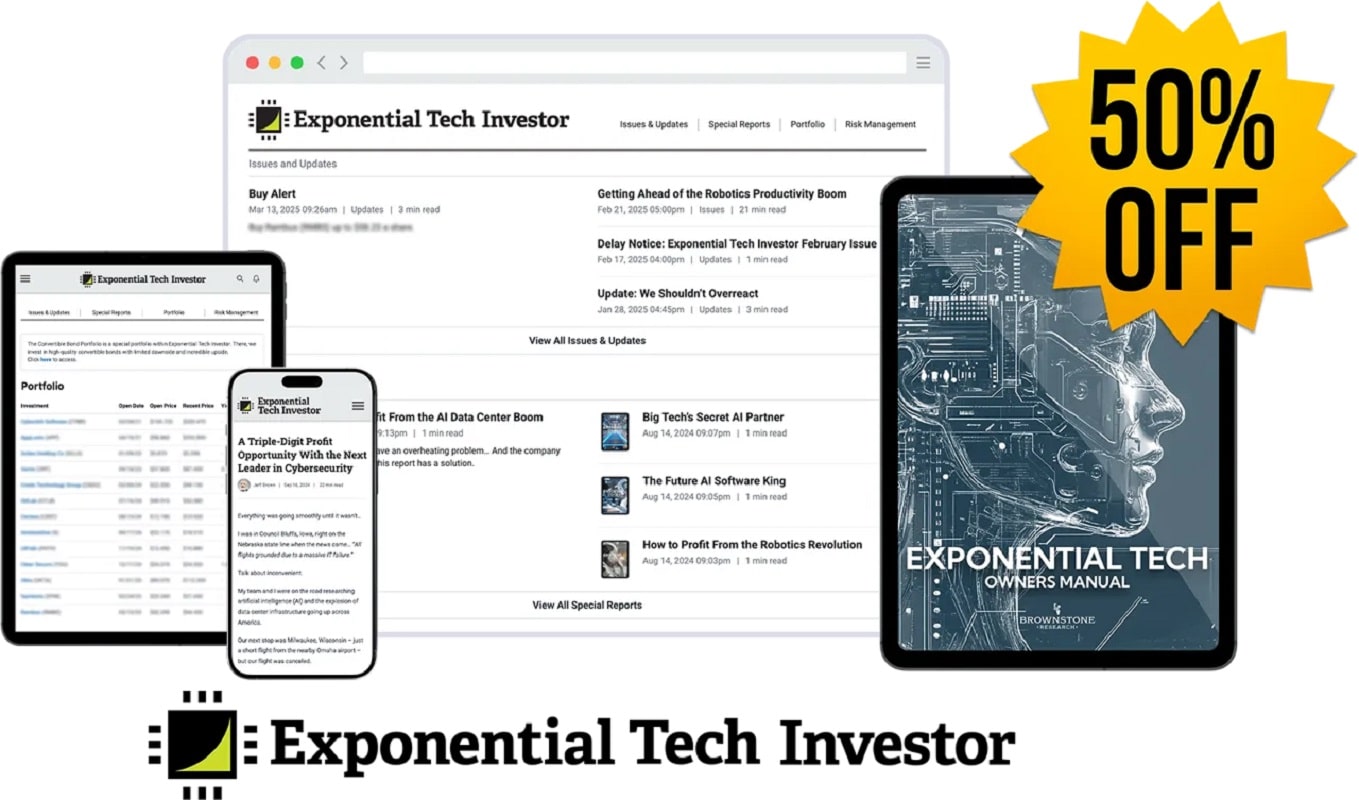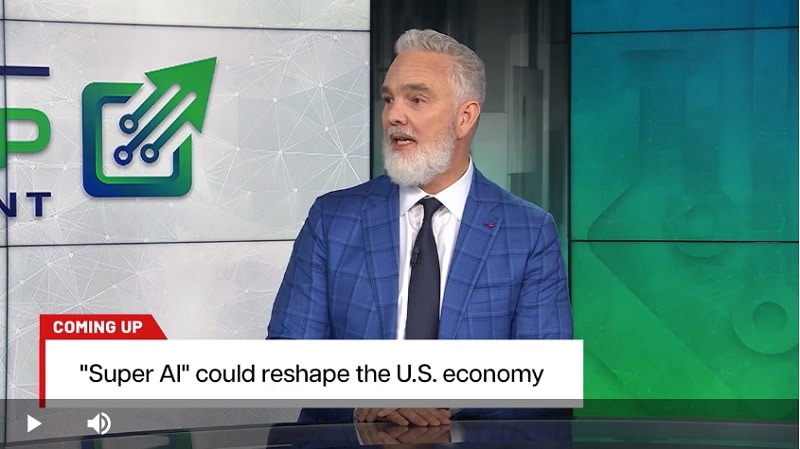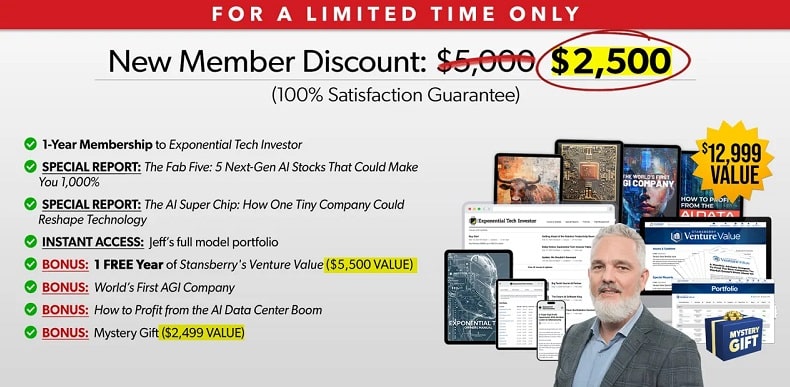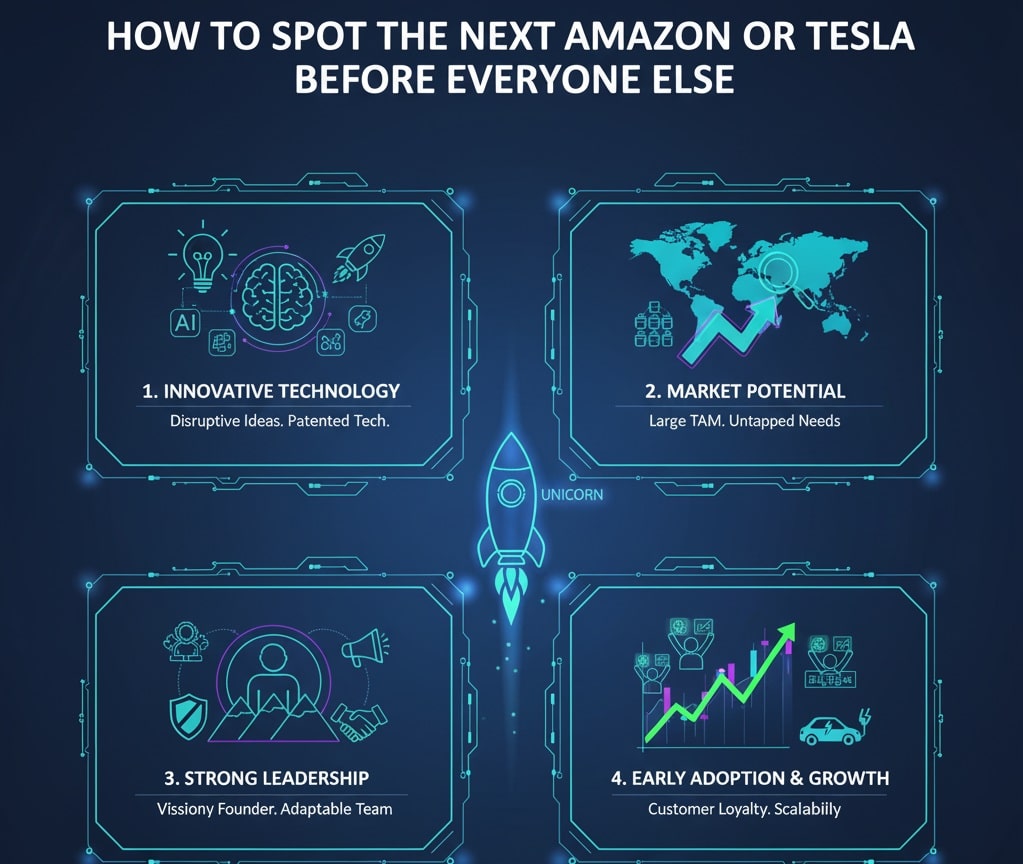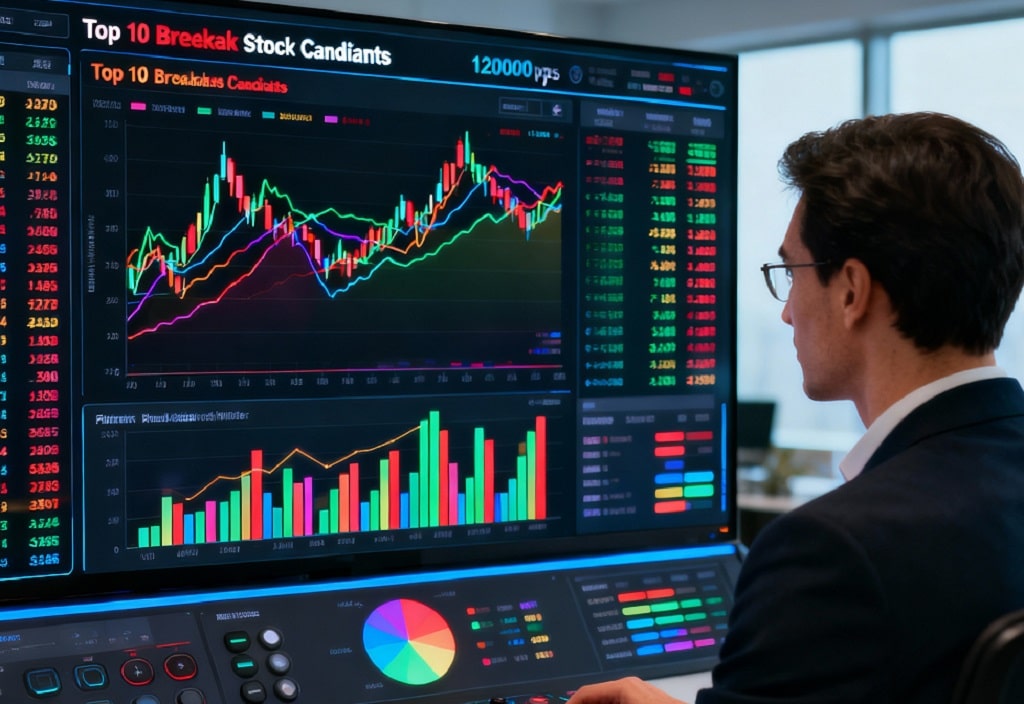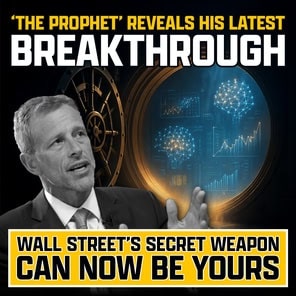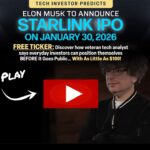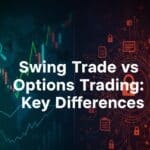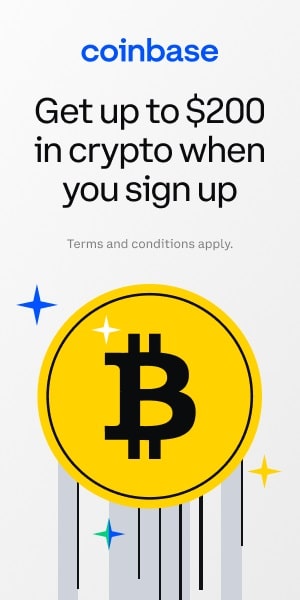Picture this: it’s 2016, and a tech insider named Jeff Brown is pounding the table on a little-known chipmaker called Nvidia. Most folks shrug—Nvidia’s just a gaming company, right? Fast-forward to today, and that stock’s up a jaw-dropping 18,300%. If you’d tossed $5,000 into it back then, you’d be sitting on nearly a million bucks.
Now, Brown’s back with a new prediction, one he says could dwarf Nvidia’s run. He’s betting on a tiny California company set to unveil a game-changing AI chip on June 2, 2025, alongside five under-the-radar stocks he calls the “Fab Five,” which could soar 1,000% or more. It’s the kind of bold call that makes you sit up and listen—but is Brown’s newsletter, Exponential Tech Investor, worth the $2,500 price tag? I dove into the details to find out, and let me tell you, it’s a wild ride.
Meet Jeff Brown: The Tech Oracle of Silicon Valley
Jeff Brown isn’t your average Wall Street suit. He’s a tech lifer who started with dreams of becoming an astronaut, earning a degree in aeronautical engineering from Purdue. Instead of blasting into space, he landed in Silicon Valley, where he spent 30 years climbing the ranks at heavyweights like Qualcomm, Juniper Networks, and NXP Semiconductors. At NXP, he helped take the company public, pocketing a 840% gain on his stock. Not too shabby.
But Brown’s real magic happens outside the C-suite. He’s an angel investor with a knack for spotting winners early. He’s made 130 private investments, 18 of which returned at least 1,000%. That’s not a typo—think 10x, 20x, even 44x returns on deals like Ripple Labs and Jumpcloud. He called bitcoin in 2015, when it was a $569 punchline, and watched it rocket 33,000%. He flagged Nvidia in 2016, long before AI was a buzzword. The guy’s got a nose for tech’s next big thing, and his credentials—MIT and Stanford certifications, advisory roles with the Defense Intelligence Agency—back it up. Even pros from the world’s biggest asset managers, including eight from one firm and 22 from JPMorgan, follow his work.
So when Brown says something big is coming, you listen. His newsletter, Exponential Tech Investor, is his way of sharing that foresight with everyday investors. It’s not about blue-chip giants; it’s about small, scrappy companies poised to explode as tech reshapes the world. And right now, Brown’s laser-focused on AI—specifically, a chip he says will change everything.
The Big Bet: A Brain-Scale AI Chip and the Fab Five
Let’s cut to the chase: Brown’s pitching a seismic shift in AI, and it’s all tied to a date—June 2, 2025. He claims a small California company is about to go public with a “brain-scale” AI chip that’s 50 times faster than Nvidia’s. This isn’t just a faster processor; it’s a leap toward mimicking the human brain, packing 120 trillion neural connections—more than the 100 trillion in your noggin. Brown says it’s 144 times more powerful than Qualcomm’s chips, 78 times better than Intel’s, and leaves Nvidia in the dust with 880 times the memory capacity.
Why does this matter? Because this chip isn’t just for training AI models (Nvidia’s forte); it’s built for “inference,” where AI starts thinking creatively, tackling new problems like a human. Think self-driving cars that dodge accidents 85% better than we do, or drugmakers slashing development time from six years to 18 months. Brown’s got proof—an SEC filing showing the company’s prepping its IPO. He predicts it’ll hit the market around June 2, sparking a frenzy like Nvidia’s 1999 debut. Miss that one? This could be your second chance.
But the chip’s just the start. Brown’s really jazzed about five small AI companies—the “Fab Five”—that’ll use this tech to disrupt everything from cars to cancer treatment. He says these stocks could replace the Magnificent 7 (think Apple, Microsoft, Nvidia) as market kings, delivering 1,000% gains for early investors. He’s cagey about their names (you need to subscribe for that), but he drops hints: one’s revolutionizing gold mining with AI-powered prospecting, another’s helping doctors beat cancer with machine learning, and a third’s coding software 100 times faster than humans. These aren’t household names, and that’s the point—Brown loves small caps for their potential to become tomorrow’s giants.
To frame the opportunity, Brown and his partner, Whitney Tilson, borrow a biblical metaphor: the “4 Horsemen” of the market—Death, Conquest, Famine, and War. It’s dramatic, sure, but it captures AI’s double-edged sword. Death means old-school companies like General Motors or Pfizer could crumble if they don’t adapt. Conquest is AI taking over sectors like medicine, where it’s already outsmarting doctors. Famine points to job losses—McKinsey says 800 million jobs could vanish globally, from tax accountants to lawyers. And War? That’s the cutthroat race among 470 chipmakers to outdo Nvidia, with Brown betting his California upstart will win.
Whitney Tilson: The Prophet Joins the Party
Brown’s not alone in this. He’s teamed up with Whitney Tilson, a hedge fund legend who turned $1 million into $200 million and earned the nickname “The Prophet” from CNBC. Tilson’s got a spooky knack for calling market turns—he nailed the dot-com crash, the 2008 bottom on 60 Minutes, and the Covid crash to the day. He bought Amazon at $2.41 a share, turning $5,000 into $218,000. When Tilson talks, Wall Street listens, and he’s all in on Brown’s June 2 prediction.
Tilson’s role isn’t just hype—he brings a bonus to the table: a free year of Stansberry’s Venture Value, a $5,500 research service that hunts for microcap gems. Think 249% gains on a software play or 400% on a law enforcement tech firm. Tilson’s involvement adds street cred and makes the deal sweeter, especially since he’s buddies with billionaires like Bill Ackman, who’s also betting big on AI.
What You Get for $2,500
So, what’s the deal? Exponential Tech Investor normally costs $5,000 a year, but Brown’s slashing it to $2,500 for this launch. For that, you get a monthly newsletter with a new small-cap pick, plus a model portfolio and updates. But the real draw is the bonus package, valued at over $12,999. Here’s the rundown:
-
The Fab Five Report: Names of the five AI stocks Brown says could hit 1,000% returns.
-
The AI Super Chip Report: The scoop on that California chipmaker, including why June 2 is make-or-break.
-
The World’s First AGI Company: A sneaky way to invest in a private firm building artificial general intelligence (AGI)—AI that thinks like a human, not just a fancy calculator. Brown says AGI’s coming within a year, and it’s a national security race against China.
-
The Next Frontier in AI: A small-cap stock in quantum computing, which Brown calls AI’s next leap. Quantum’s so powerful, Google’s Willow chip did a calculation in five minutes that’d take a supercomputer 10 billion years.
-
How to Profit from the AI Data Center Boom: A pick for the $1 trillion data center market, where AI’s gobbling up storage like there’s no tomorrow. One example, Vertiv Holdings, is up 800%.
-
Top 5 AI Stocks to Avoid: A warning about overhyped duds like SoundHound AI, which Brown and Tilson say is toast thanks to Amazon’s new speech tech.
-
Guide for Risk Management: Tips to handle the rollercoaster of small-cap investing, like setting stop losses and sizing positions right.
-
Stansberry’s Venture Value: Tilson’s $5,500 microcap service, free for a year.
-
Surprise Bonus: A mystery report Brown says you’ll love (no spoilers here).
Oh, and there’s a 30-day guarantee: if you’re not happy, you can swap your $2,500 for credit toward other Stansberry or Brownstone products. No cash refunds, but it’s a solid safety net from a firm with a 26-year rep.
The Good, the Bad, and the Risky
Let’s break it down: is Exponential Tech Investor worth your hard-earned cash? I’ll weigh the pros and cons, because this isn’t a decision to make lightly.
Why It’s Tempting
-
Brown’s Track Record Is Legit: The guy’s called Nvidia, Tesla (up 2,100%), and bitcoin, plus 18 private deals with 1,000%+ returns. In 2018, he picked the top two small caps in the Russell 1,000 during a brutal bear market. That’s not luck—that’s skill.
-
Small Caps, Big Dreams: Small caps can skyrocket, and Brown’s got a knack for finding them. He cites AutoZone (up 8,311%) and Intuitive Surgical (up 23,764%) as proof that today’s minnows can become whales. A study he mentions says small caps get less analyst love, leaving gems for savvy investors.
-
AI’s the Real Deal: AI’s growing faster than the iPhone or Facebook, with ChatGPT hitting 100 million users in two months. Brown’s chip thesis aligns with big moves, like the $500 billion Stargate initiative and Ray Kurzweil’s claim that AI will “rupture human history.”
-
Bonuses Galore: The reports on AGI, quantum computing, and data centers, plus Tilson’s Venture Value, make this a one-stop shop for tech investing. At $2,500, it’s a steal compared to the $12,999 value.
-
Risk-Aware Approach: Brown’s not selling a get-rich-quick scheme. His risk management guide and warnings about duds like SoundHound show he’s serious about protecting your wallet.
Where It Gets Dicey
-
It Ain’t Cheap: $2,500 is a lot, especially with no cash refund. The credit guarantee helps, but if you’re on a tight budget, it’s a gamble.
-
Small Caps Are Wild: These stocks can soar, but they can also crash. Brown admits not every pick pans out, and the text warns against betting more than you can lose. If volatility keeps you up at night, this might not be your jam.
-
Hype Can Feel Overblown: The “4 Horsemen” shtick and talk of 800 million job losses sound like a sci-fi flick. Brown’s stunt—blindfolded in a self-driving car—is cool but feels like a marketing ploy. It might rub skeptics the wrong way.
-
June 2 Isn’t Guaranteed: Brown’s banking on that IPO, but he hedges, saying it could be “days or weeks” off. If the timing’s wrong, you might be left twiddling your thumbs.
-
You Don’t Get the Names Upfront: Want to know the Fab Five or the chipmaker? Pony up first. That opacity could frustrate folks who like to peek under the hood before buying.
Why the Fab Five Have Me Curious
The Fab Five are what really got my attention. Brown’s not just hyping a chip; he’s betting on a whole ecosystem of AI companies that’ll ride its coattails. He paints a vivid picture: one’s using AI to find gold deposits faster than old-school miners, another’s helping doctors save cancer patients with treatments humans missed, and a third’s writing code so fast it’s making programmers sweat. These aren’t pie-in-the-sky ideas—Brown points to real-world wins, like an AI drugmaker cutting cancer remission times and a gold miner uncovering a massive palladium deposit.
What’s exciting is the small-cap angle. Brown compares these stocks to eBay (up 7,000%) and Booking Holdings (up 29,000%), which started small and crushed it by disrupting dinosaurs like newspapers and travel agencies. The Fab Five could do the same, especially with AI’s insane growth—think ChatGPT’s user boom or the $1 trillion data center market. Brown’s track record gives me confidence he’s not just throwing darts; he’s got a system, rooted in his “brain-scale” chip obsession, that’s worked before.
But here’s the flip side: small caps are a rollercoaster, and Brown’s not naming names unless you subscribe. That secrecy’s a bummer, but it’s standard for newsletters. Still, the idea of getting in early on the next Apple or Amazon, especially with AI’s momentum, is hard to ignore.
Free Picks: Amazon, Astera Labs, and a Big Nope
Brown doesn’t leave you empty-handed. He shares two stocks to buy and one to dodge, no subscription required:
-
Amazon (AMZN): Yeah, it’s not a small cap, but Brown calls it an “AI company in disguise.” Its Amazon Web Services (AWS) powers AI for tons of businesses, and it’s rolling out new models like Nova Sonic. Down 24% this year, it’s trading at 2.6 times sales, which Brown says is a steal for a cash-flow machine. Tilson agrees, calling it a “buy-and-hold-forever” stock.
-
Astera Labs (ALAB): This one’s more Brown’s style—a small-cap semiconductor firm he dubs “Nvidia’s silent partner.” Its tech’s in 80% of AI servers, working with giants like Nvidia and AMD. If AI keeps booming, Astera’s got serious upside.
-
SoundHound AI (SOUN): Steer clear, says Brown and Tilson. This speech recognition company’s tech is outdated, and it’s burning $60 million a year with no profits in sight. Amazon’s Nova Sonic is set to crush it, and Wall Street’s short-sellers are circling. Even after a 50% drop, its $3 billion valuation looks shaky.
These picks show Brown’s range: a safe bet on a tech titan, a high-growth small cap, and a warning to avoid the hype. It’s a taste of what you’d get as a subscriber, and it builds trust that he’s not just peddling moonshots.
Should You Pull the Trigger?
So, is Exponential Tech Investor worth it? If you’ve got $2,500 to spare, a stomach for risk, and a belief that AI’s about to reshape the world, I’d say it’s a strong contender. Brown’s not some fly-by-night guru; his resume and track record are the real deal. The June 2 prediction is intriguing, especially with that SEC filing backing it up. The Fab Five sound like the kind of bets that could turn a modest stake into a windfall, and the bonuses—AGI, quantum computing, data centers—cover all the bases of tech’s next wave. Tilson’s Venture Value and the credit guarantee sweeten the pot, making it feel like you’re getting a lot for your money.
But let’s be real: $2,500 isn’t pocket change, and small caps can be a wild ride. If you’re retired or risk-averse, you might want to stick with Brown’s free picks—Amazon and Astera Labs are solid without the subscription. The hype around the 4 Horsemen and job losses can feel like a pressure tactic, and the lack of upfront stock names is a hurdle. Plus, if the June 2 IPO slips, you’ll need patience.
For me, the Fab Five are the clincher. The idea of catching the next eBay or Intuitive Surgical at the ground floor, powered by a chip that outsmarts Nvidia, is tantalizing. Brown’s been right before, and AI’s no fad—think $500 billion government projects and FDA-approved AI devices spiking since 2015. If you’re ready to hold on tight, this could be your ticket to the AI revolution.
Final Thoughts: Don’t Miss the AI Train
Jeff Brown’s Exponential Tech Investor is like a backstage pass to the AI boom. It’s not perfect—the price stings, and the hype can be a lot—but it’s backed by a guy who’s called some of the biggest tech wins of our time. The Fab Five and that brain-scale chip have me genuinely curious, and the bonuses make it a no-brainer for tech junkies. As Brown puts it, “You have more to lose by NOT at least gaining some exposure to this megatrend.” If you missed Nvidia’s rocket ride, June 2 could be your shot at redemption. Just don’t expect a smooth ride—grab a helmet and enjoy the view.
Exponential Tech Investor FAQ
What is Exponential Tech Investor?
Exponential Tech Investor is a monthly newsletter from Brownstone Research, led by tech veteran Jeff Brown. It delivers stock picks for small- and microcap companies in emerging tech sectors, especially artificial intelligence (AI). Each issue includes a new recommendation, detailed analysis, and updates on Brown’s model portfolio, aiming to spot companies with 10x or greater growth potential.
Who is Jeff Brown, and why should I trust him?
Jeff Brown is a Silicon Valley insider with 30 years of experience at companies like Qualcomm and NXP Semiconductors. He’s an angel investor with 130 private investments, including 18 tech deals that returned at least 1,000%. His early calls on Nvidia (up 18,300% since 2016) and bitcoin (up 33,000% since 2015) show his knack for spotting trends. He’s advised the U.S. government and is followed by pros from top asset managers, giving him serious cred in the tech investing world.
What’s the big deal about the June 2, 2025, prediction?
Brown predicts that on or around June 2, 2025, a small California company will go public, unveiling a “brain-scale” AI chip that’s 50 times faster than Nvidia’s. This chip, with 120 trillion neural connections, is built for AI “inference” work—think creative problem-solving for self-driving cars or drug discovery. Backed by an SEC filing, Brown says this IPO could spark a market frenzy, driving gains for five related AI stocks he calls the “Fab Five.”
What are the “Fab Five” stocks?
The Fab Five are five small- or microcap AI companies Brown believes will leverage the AI Super Chip to disrupt industries like automotive, medicine, and mining. Examples include a firm using AI to find gold deposits, another speeding up cancer treatments, and one coding software 100 times faster than humans. Brown claims they could deliver 1,000% returns, but you’ll need to subscribe to get their names.
Who is Whitney Tilson, and what’s his role?
Whitney Tilson is a former hedge fund manager who grew $1 million into $200 million and accurately predicted the dot-com crash, 2008 financial crisis bottom, and Covid crash bottom. Nicknamed “The Prophet” by CNBC, he endorses Brown’s June 2 prediction and contributes a free year of his Stansberry’s Venture Value service, which focuses on microcap stocks with big potential.
What are the free stock picks Brown offers?
Without subscribing, Brown recommends:
- Astera Labs (ALAB): A small-cap semiconductor firm in 80% of AI servers, partnered with Nvidia and AMD, poised for growth. He warns against SoundHound AI (SOUN), citing its outdated tech and $60 million annual losses, especially with Amazon’s Nova Sonic gaining ground.
- Amazon (AMZN): An “AI company in disguise” via its AWS division, trading at 2.6 times sales after a 24% drop, offering value and AI exposure.
Is Exponential Tech Investor worth the $2,500 price tag?
It depends. If you’re comfortable with risk, have $2,500 to invest, and believe in AI’s potential, the newsletter’s a strong bet. Brown’s track record, the Fab Five’s upside, and bonuses like Tilson’s service make it compelling. But $2,500 is steep, small caps are volatile, and the June 2 IPO timing isn’t guaranteed. Conservative investors might prefer sticking with the free picks (Amazon, Astera Labs).
What are the risks of subscribing?
- Cost: $2,500 is a big commitment, with only a credit (not cash) refund option.
- Volatility: Small-cap stocks can soar or crash, and Brown notes not all picks succeed.
- Timing Uncertainty: The June 2 IPO could be delayed by days or weeks, requiring patience.
- Hype Factor: The “4 Horsemen” narrative and job loss warnings might feel alarmist, potentially clouding judgment.
- Limited Transparency: You won’t see the Fab Five or chipmaker’s names without subscribing.
How does Brown manage the volatility of small-cap stocks?
Brown includes a risk management guide with strategies like setting stop losses and proper position sizing. He emphasizes only investing what you can afford to lose and warns against overhyped stocks like SoundHound AI, showing a focus on protecting subscribers from small-cap pitfalls.
Why is AI such a big focus for Brown?
AI’s growing at breakneck speed—ChatGPT hit 100 million users in two months, and computational power doubles every six months. Brown sees the AI Super Chip as a catalyst for next-gen applications, from 85% safer self-driving cars to drug discovery that’s 80–90% more effective. With initiatives like the $500 billion Stargate project and experts like Ray Kurzweil predicting AI’s dominance, Brown believes it’s the ultimate wealth-building trend.
Can I try it risk-free?
Sort of. There’s a 30-day guarantee, but it’s not a cash refund—you can apply your $2,500 to other Stansberry or Brownstone products. It’s a decent safety net, backed by Brownstone’s 26-year reputation, but you’ll need to commit upfront.
How do I sign up, and where can I learn more?
To subscribe or get details, visit Brownstone Research’s official page here. The site outlines the subscription process, current discount, and bonus reports.
I’m new to investing—Is this for me?
If you’re a beginner, proceed with caution. The newsletter targets investors comfortable with high-risk, high-reward small-cap stocks. Brown’s risk management guide helps, but the $2,500 cost and volatility might be intimidating. Start with his free picks (Amazon, Astera Labs) to dip your toes in AI investing without the commitment.
What if I missed Nvidia’s rise? Is this my second chance?
Brown thinks so. He compares the June 2 IPO to Nvidia’s 1999 debut, suggesting the Fab Five could mirror early wins like eBay (up 7,000%) or Intuitive Surgical (up 23,764%). While nothing’s guaranteed, his track record and AI’s momentum make it a tantalizing opportunity for those who regret missing the last tech wave.

